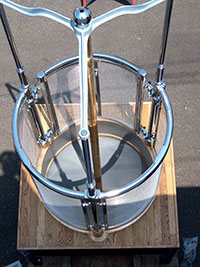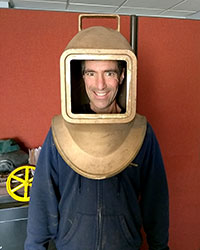
Firehouse slide pole assembly, as seen from above.
By William C. Shelton
An unremarkable white building in Boynton Yards houses an enterprise that is one of Somerville’s enduring treasures. A list of its products would be longer than this entire column, but you see them every day.
They include baroque railings for old buildings, the ubiquitous mushroom caps on MWRA vents, clock-tower parts, Boston Public Library lamps, aluminum street signs, U.S.S. Constitution brightwork, MBTA train and infrastructure parts, firehouse slide poles, brass Hatch Shell lettering, sculptures by well-known artists, and the castings for Somerville’s Arrow Paper Fire and 9/11 Memorials.
Founded by Arthur Anthony Sr. in 1936, the Mystic Valley Foundry set up operations on Horace Street in 1940 and has been casting nonferrous metal products ever since. It’s the first place that I thought of when my friend, Alex Feldman, proposed a series of columns about family-owned Somerville businesses that have survived the vicissitudes of deindustrialization and big-box stores.
Well … the second, actually. But I wrote a column about Nissenbaums’ Auto Recycling Center in 2010.
Arthur Anthony III currently manages the Foundry, and he was a warm and welcoming host to Alex and I last week.
Metal casting, along with trade networks and agriculture, ushered in the Bronze Age 5,300 years ago, establishing a material basis for civilization. Arthur says that the essentials remain the same: “Sand is physically compacted around a form. It retains that shape, into which molten metal is poured.”
Of course, the technology has improved over the millennia. The earliest bronze was a copper and arsenic alloy. Substituting tin for arsenic produced a harder metal. Because copper and tin ores are rarely found together, bronze production required the development of trade, which brought the exchange of other goods as well.

Alex in a brass diving helmet.
Although some ancient metallurgists tried alloying copper with zinc, rather than with tin, the technique was not perfected until the post-medieval period, producing modern-era brass.
Attempts to produce aluminum metal were unsuccessful until 1824, and the metal remained more expensive than gold for another thirty years. But once aluminum production became economical, its corrosion resistance and low density made it attractive for uses ranging from jewelry to aerospace.
Operations like the Mystic Valley Foundry continue to innovate, improving product and process technologies incrementally, or as Arthur says, “at the fringes.” And while today’s new inventions often require molded metal parts, older products and their replacement parts remain a mainstay to sales. Mystic Valley Foundry, for example, continues to deliver brass slide poles to fire houses all over the planet.
The fact is that foundries remain the fastest and most cost-effective means of producing complex metal shapes. Machining a part from a metal block is more labor- and capital-intensive than casting. And the metal block by itself can be more expensive than the material and labor required for foundry production.
Although metal 3D printing exists, it is phenomenally expensive. But an inventor or designer can produce a required shape in plastic with a 3D printer, and then use it to produce a mold used to make the metal part.
Arthur assists inventors with engineering and product designs, producing patterns, specifying alloys, and developing prototypes. He’s also a lifesaver when it comes to reproducing parts for devices long out of production, like the 1917 machines that still make Necco Wafers, or an Hispano-Suiza intake manifold from the same era.
On a casual tour of the foundry we saw parts being manufactured for box making equipment, electrical motors, machines for making semiconductors and fortune cookies, high-end audio applications, and wind-powered generators. We saw brass architectural scroll work, replacements for old Brookline street signs, oar locks, a device for shifting the position of a boat’s propeller, and a brass diving helmet.
When Arthur asked Alex if he would like to try on the latter, it was so heavy, it took both Arthur and I to lift it onto his shoulders.
One might imagine a foundry to be a “dirty” industry. But while those who work in it certainly get their hands dirty, its environmental impacts are relatively benign. Its furnaces are fired by natural gas, which produces negligible amounts of sulfur, mercury, and particulates, and much lower levels of nitrogen oxide and CO2, than do automobiles. Metal scraps left over from production are recycled over and over.
It also provides workers without a college education that kind of living-wage employment that Somerville’s 160 manufacturing concerns created in the middle of the last Century.
What the foundry is not, is portable. Moving it would require capital investment in plant and equipment that the industry’s low rate of return would be unable to amortize. Similar economics have reduced foundries in Connecticut from over 170 in the 1970s to five today. And only similar handful remains in Massachusetts.
So as city officials plan and zone Boynton Yards, they should ensure the Foundry’s continued existence. Not just because it’s a living legacy of the 20th Century industrial base that created the Somerville we love, but also because there are numerous small businesses that cannot exist without the products that it makes. And it is a repository of accumulated technology, craft, and institutional memory that only survives as a going concern.












Watch – The City will run these guys off, and then replace them with a luxury condo building with a name like Forge or Bronze Block. (y’know . . as an homage to Somerville history.)